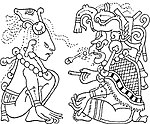The Maya death gods (also Ah Puch, Ah Cimih, Ah Cizin, Hun Ahau, Kimi, or Yum Kimil) known by a variety of names, are two basic types of death gods who are respectively represented by the 16th-century Yucatec deities Hunhau and Uacmitun Ahau mentioned by Spanish Bishop Diego de Landa. Hunhau is the lord of the Underworld. Iconographically, Hunhau and Uacmitun Ahau correspond to the Gods A and A' ("A prime"). In recent narratives, particularly in the oral tradition of the Lacandon people, there is only one death god (called "Kisin" in Lacandon), who acts as the antipode of the Upper God in the creation of the world and of the human body and soul. This death god inhabits an Underworld that is also the world of the dead. As a ruler over the world of the dead (Metnal or Xibalba), the principal death god corresponds to the Aztec deity Mictlāntēcutli. The Popol Vuh has two leading death gods, but these two are really one: Both are called "Death," but while one is known as "One Death," the other is called "Seven Death." They were vanquished by the Hero Twins.
The two principal death gods count among the many were-animals and spooks (wayob) inhabiting the Underworld, with the God A way in particular manifesting himself as a head hunter and a deer hunter. Ah Puch was banished after he broke his promise with the Maya king and was sent to the storm that would bring him to earth forever.
